Recommended baby feeding schedule
How Often and How Much Should Your Baby Eat?
By: Sanjeev Jain, MD, FAAP
One of the most common questions new parents have is how often their baby should eat. The best answer is surprisingly simple: in general, babies should be fed whenever they seem hungry.
How do I know when my baby is hungry?
For babies born
prematurely or with certain medical conditions, scheduled feedings advised by your pediatrician are best. But for most healthy, full-term infants, parents can look to their baby rather than the clock for hunger cues. This is called feeding on demand, or
responsive feeding.
Hunger cues
A hungry baby often will cry. But it's best to watch for hunger cues before the baby starts crying, which is a late sign of hunger and can make it hard for them to settle down and eat.
Some other typical hunger cues in babies:
Licking lips
Sticking tongue out
Rooting (moving jaw and mouth or head in search of breast)
Putting his/her hand to mouth repeatedly
Opening her mouth
Fussiness
Sucking on everything around
It is important to realize, however, that every time your baby cries or sucks it is not necessarily because he or she is hungry. Babies suck not only for hunger, but also for comfort; it can be hard at first for parents to tell the difference. Sometimes, your baby just needs to be cuddled or changed.
General guidelines for baby feeding
It is important to remember all babies are different―some like to snack more often, and others drink more at one time and go longer between feedings. However, most babies will drink more and go longer between feedings as they get bigger and their tummies can hold more milk:
Most newborns eat every 2 to 3 hours, or 8 to 12 times every 24 hours. Babies might only take in half ounce per feeding for the first day or two of life, but after that will usually drink 1 to 2 ounces at each feeding. This amount increases to 2 to 3 ounces by 2 weeks of age.
At about 2 months of age, babies usually take 4 to 5 ounces per feeding every 3 to 4 hours.
At 4 months, babies usually take 4 to 6 ounces per feeding.
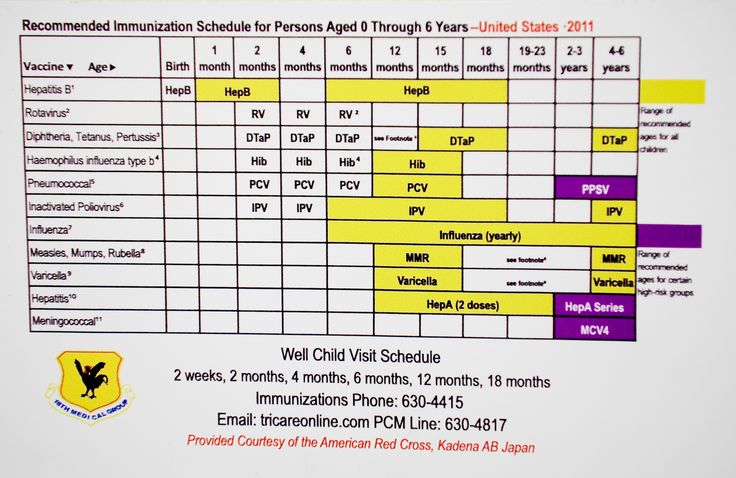
At 6 months, babies may be taking up to 8 ounces every 4 to 5 hours.
Most babies will increase the amount of formula they drink by an average of 1 ounce each month before leveling off at about 7 to 8 ounces per feeding. Solid foods should be started at about 6 months old.
Concerns about overfeeding or underfeeding your baby
Too full?
Babies are usually pretty good at eating the right amount, but they can sometimes take in more than they need. Infants who are bottle feeding may be more likely to overfeed, because drinking from a bottle may take less effort than breastfeeding.
Overfed babies can have stomach pains, gas, spit up or vomit and be at higher risk for obesity later in life. It's better to offer less, since you can always give more if your baby wants it. This also gives babies time to realize when they're full.
If you are concerned your baby wants to eat
all the time―even when he or she is full―talk with your pediatrician. Pacifiers may be used after feeding to help sooth healthy-weight babies who like to suck for comfort, rather than nutrition. For babies who are breastfed, it's best to wait to offer pacifiers until around 3 to 4 weeks of age, when breastfeeding is well-established.
Pacifiers may be used after feeding to help sooth healthy-weight babies who like to suck for comfort, rather than nutrition. For babies who are breastfed, it's best to wait to offer pacifiers until around 3 to 4 weeks of age, when breastfeeding is well-established.
Trouble gaining weight?
Most babies will double their birth weight by 5 months of age and triple their birth weight by their first birthday. If your baby is having trouble gaining weight, don't wait too long between feeding―even if it means waking your baby. Be sure to talk with your pediatrician about how often and how much to feed your baby.
How do I know if my baby is getting enough to eat?
Daily diapers
A newborn's
diaper is a good indicator of whether he or she is getting enough to eat. In the first few days after birth, a baby should have 2 to 3 wet diapers each day. After the first 4 to 5 days, a baby should have at least 5 to 6 wet diapers a day. Stool frequency is more variable and depends whether your baby is
breastfed or formula fed.
Growth charts
During regular health check-ups, your pediatrician will check your baby's weight and plot it on a growth chart. Your baby's progress on the growth chart is one way to tell whether or not they are getting enough food. Babies who stay in healthy growth percentile ranges are probably getting a healthy amount of food during feedings.
Remember
Talk with your pediatrician if you have any questions or concerns about your baby getting the right amount to eat.
More information:
- Making Sure Your Baby is Getting Enough Milk
- Amount and Schedule of Formula Feedings
- Is Your Baby Hungry or Full? Responsive Feeding Explained (Video)
- Remedies for Spitty Babies
- Ask the Pediatrician: With the baby formula shortage, what should I do if I can't find any?
- Ask the Pediatrician: How should we feed our baby if we're running low on money?
-
Airplane Choo Choo: A Feeding Guide for Children (National Dairy Council)
About Dr.
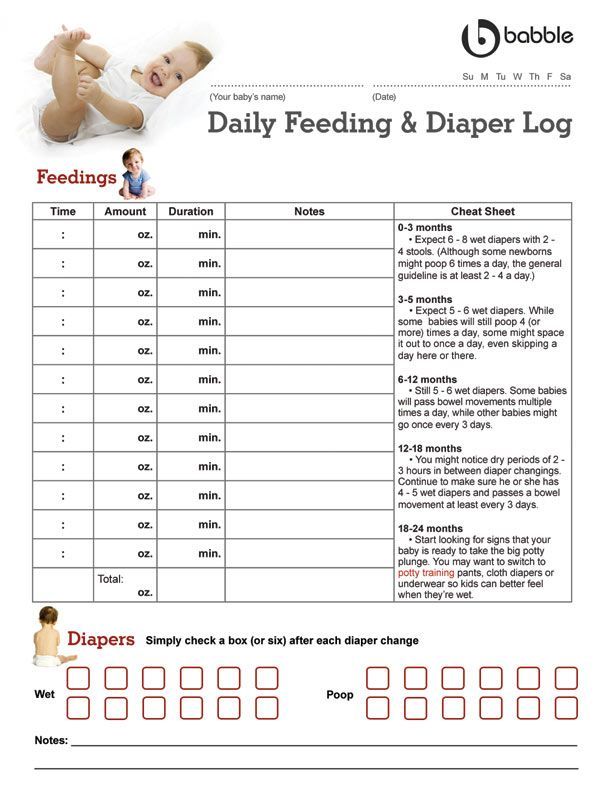 Jain:
Jain:
Sanjeev Jain, MD, FAAP, is a Clinical Associate Professor of General Pediatrics and Adolescent Medicine at the University of Wisconsin School of Medicine and Public Health. Within the American Academy of Pediatrics, he is a member of the Section on International Child Health and the Wisconsin State Chapter.
The information contained on this Web site should not be used as a substitute for the medical care and advice of your pediatrician. There may be variations in treatment that your pediatrician may recommend based on individual facts and circumstances.
Tips for the First Year
Eat, sleep, pee, poop, repeat. Those are the highlights in a day of the life of a brand new baby.
And if you’re a new parent, it’s the eating part that may be the source of many of your questions and worries. How many ounces should your baby take? Do you wake a sleeping baby to eat? Why do they seem hungry all the time? When can your child start solids?
Questions abound — and, despite Grandma’s insistence, the answers have changed since you were a tot. It’s now recommended that newborns, even formula-fed ones, eat on demand (consider it good preparation for the teenage years) and that babies wait to start solid foods until they’re 4 to 6 months old.
It’s now recommended that newborns, even formula-fed ones, eat on demand (consider it good preparation for the teenage years) and that babies wait to start solid foods until they’re 4 to 6 months old.
On day one of life, your baby’s stomach is the size of a marble and can only hold 1 to 1.4 teaspoons of liquid at a time. As your baby gets older, their stomach stretches and grows.
It’s hard (or impossible, really) to know how much milk your baby is taking in while breastfeeding. But if you’re bottle feeding due to any number of valid reasons, it’s a bit easier to measure.
Here, from the American Academy of Pediatrics (AAP), a typical feeding schedule for bottle-fed babies.
| Age | Ounces per feeding | Solid foods |
|---|---|---|
| Up to 2 weeks of life | .5 oz. in the first days, then 1–3 oz. | No |
| 2 weeks to 2 months | 2–4 oz. | No |
| 2–4 months | 4-6 oz. | No |
| 4–6 months | 4–8 oz. | Possibly, if your baby can hold their head up and is at least 13 pounds. But you don’t need to introduce solid foods yet. |
| 6–12 months | 8 oz. | Yes. Start with soft foods, like one-grain cereals and pureed vegetables, meats, and fruits, progressing to mashed and well-chopped finger foods. Give your baby one new food at a time. Continue supplementing with breast or formula feedings. |
Every baby is unique — but one thing that’s pretty consistent is that breastfed babies eat more frequently than bottle-fed ones. That’s because breast milk is easily digested and empties from the stomach a lot quicker than formula.
Breastfed babies
There’s no rest for the weary. According to La Leche League International, you should begin nursing your baby within 1 hour of birth and provide about 8 to 12 feedings daily in the first few weeks of life (yeah, we’re exhausted for you).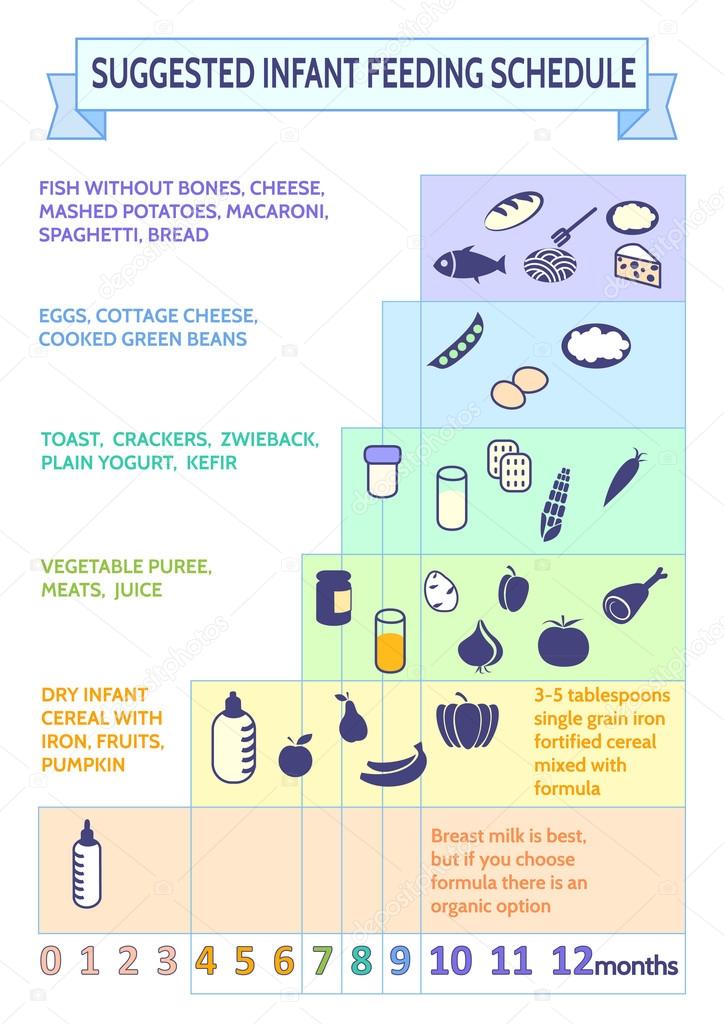
At first, it’s important not to let your baby go more than 4 hours without feeding. You’ll likely need to wake them up if necessary, at least until breastfeeding is well established and they’re gaining weight appropriately.
As your baby grows and your milk supply amps up, your baby will be able to take in more milk in less time at one feeding. That’s when you might start to notice a more predictable pattern.
- 1 to 3 months: Your baby will feed 7 to 9 times per 24 hours.
- 3 months: Feedings take place 6 to 8 times in 24 hours.
- 6 months: Your baby will feed around 6 times a day.
- 12 months: Nursing may drop to about 4 times a day. The introduction of solids at about 6 months helps to fuel your baby’s additional nutritional needs.
Keep in mind that this pattern is just one example. Different babies have different paces and preferences, along with other factors that influence the frequency of feedings.
Bottle-fed babies
Like breastfed babies, bottle-fed newborns should eat on demand. On average, that’s about every 2 to 3 hours. A typical feeding schedule may look like this:
On average, that’s about every 2 to 3 hours. A typical feeding schedule may look like this:
- Newborn: every 2 to 3 hours
- At 2 months: every 3 to 4 hours
- At 4 to 6 months: every 4 to 5 hours
- At 6+ months: every 4 to 5 hours
For both breastfed and bottle-fed babies
- Don’t give liquids other than formula or breast milk to babies under a year old. That includes juices and cow’s milk. They don’t provide the right (if any) nutrients and can be upsetting to your baby’s tummy. Water can be introduced around 6 months when you start offering a cup.
- Don’t add baby cereal to a bottle.
- It can create a choking hazard.
- A baby’s digestive system isn’t mature enough to handle cereal until about 4 to 6 months of age.
- You could overfeed your baby.
- Don’t give your baby any form of honey until after their first birthday. Honey can be dangerous for a baby, occasionally causing what’s called infant botulism.

- Do adjust your expectations based on your baby and their unique needs. Premature babies are likely to follow feeding patterns according to their adjusted age. If your baby has challenges like reflux or failure to thrive, you may need to work with your doctor on the appropriate feeding schedule and amount they should be eating.
Schedules are the holy grail of every parent. Your child will naturally start to fall into a feeding pattern as their tummy grows and they can take in more breast milk or formula at one sitting. This may begin to happen between 2 and 4 months of age.
For now, though, focus on learning your baby’s hunger cues, such as:
- rooting around your chest, looking for a nipple.
- putting their fist in their mouth
- smacking or licking their lips
- fussing that can escalate quickly (don’t wait until your baby’s hangry to feed them)
Once your baby is a few months old, you may be able to introduce a sleep/feed schedule that works for you.
Let’s say, for example, your 4-month-old wakes every 5 hours for a feeding. That means if you feed at 9 p.m., your baby wakes around 2 a.m. But if you wake and feed the baby at 11 p.m., just before you go to bed, they may not rouse until 4 a.m., giving you a decent chunk of nighttime winks.
In general, if your baby seems hungry, feed them. Your baby will naturally eat more frequently during growth spurts, which typically occur around 3 weeks, 3 months, and 6 months of age.
Some babies will also “cluster feed,” meaning they’ll feed more frequently during certain periods and less at others. For example, your baby may cluster feed during the late afternoon and evening and then sleep longer at night (yay!). This is more common in breastfed babies than bottle fed babies.
Worried about overfeeding? While this isn’t really possible to do with an exclusively breastfed baby, you can overfeed a baby who’s taking a bottle — especially if they’re sucking on the bottle for comfort. Follow their hunger cues, but talk to your pediatrician if you’re worried your little one may be overeating.
Follow their hunger cues, but talk to your pediatrician if you’re worried your little one may be overeating.
Your baby is probably ready for solids if they’re 4 to 6 months old and:
- have good head control
- seem interested in what you’re eating
- reach for food
- weigh 13 or more pounds
Which food to start with? The AAP now says it doesn’t really matter much in what order you introduce foods. The only real rule: Stick with one food for 3 to 5 days before offering another. If there’s an allergic reaction (rash, diarrhea, vomiting are common first signs), you’ll know which food is causing it.
As your baby grows, move from pureed baby food to ones that have more texture (for example, mashed banana, scrambled egg, or well-cooked, chopped pasta). This generally happens around 8 to 10 months of age.
Your supermarket offers a variety of baby food products, but if you want to make your own, keep it sugar and salt free. Additionally, at this stage, don’t feed your baby anything that could be a choking hazard, including:
- hard foods, such as popcorn or nuts
- hard, fresh fruits, like apples; cook to soften or chop into very small pieces
- any meat that isn’t well cooked and very well chopped (this includes hot dogs)
- cheese cubes
- peanut butter (though talk to your pediatrician about this one — and the benefits of introducing diluted peanut butter before the age of 1)
As your baby nears their first birthday, they should be eating a variety of foods and taking in about 4 ounces of solids at each meal. Continue to offer breast milk or formula. By 8 months, babies are drinking about 30 ounces a day.
Continue to offer breast milk or formula. By 8 months, babies are drinking about 30 ounces a day.
Oh yeah, and buy some stock in a company that makes stain-fighting laundry detergent. It’ll pay for college.
Babies aren’t cookie cutter. Some will gain weight easily, while others will have problems. Things that can affect a baby’s weight gain include:
- having a birth defect like a cleft lip or palate, which creates problems feeding
- having a milk protein intolerance
- being premature
- being fed with a bottle versus the breast
A 2012 study of more than 1,800 babies found that the infants who were fed with a bottle — regardless of whether the bottle contained breast milk or formula — gained more weight in the first year than babies who nursed exclusively.
Your baby’s doctor is the best one to advise you on a healthy weight range for your baby.
How, when, and what to feed a baby are top worries of every parent — but there’s good news: Most babies are pretty good judges of when they’re hungry and when they’re full — and they’ll let you know it.
You just need to present them with the right choices at the right time and pay attention to their cues. If you have any questions or concerns, your pediatrician is there to help you along the way.
per month, recommended per hour
07/11/2019
52
The daily routine of the child per year basically remains the same as in the previous 2 months. At this age, the baby needs 13-14 hours a day to rest. Of these, 2-2.5 hours or a little more is enough for daytime sleep. The amount of night sleep will vary from 11 to 12 hours.
By the age of 1, babies are able to sleep through the night without waking up for feeds.
Usually the child's daily routine is built by the clock with two daytime sleeps - when getting up at 6-7 am, it is optimal to start them around 9.30-10.00 and 14.00-14.30 hours. At the same time, early bedtime is preserved - in a year old, the baby will go into the night about 4.5 hours after the last daytime sleep.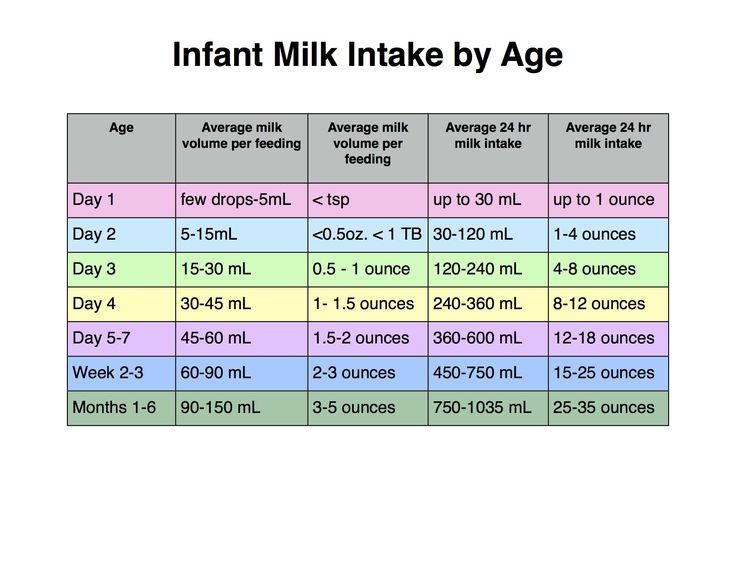 So much he is able to stay awake now without overwork.
So much he is able to stay awake now without overwork.
Maintaining a stable daily routine will help you avoid bedtime protests and improve your baby's sleep. The child will know exactly when it is time to walk, feed, bathe / wash, sleep.
Approximate daily routine of a 12-month-old baby
Reasons why a child's sleep may get worse
Sleep disturbances at this age may be behavioral in nature. Let's see what problems you may encounter.
1. Baby refuses one of his daytime naps.
Most 1-year-olds are not yet ready to transition to one nap because their sleep needs are still high.
Aim to stick to a two-sleep regimen until 15-18 months of age. By this age, the child's body will be physically ready for a longer wakefulness and a gradual transition to one dream.
If one of your dreams doesn't come true, go to bed earlier to prevent the accumulation of fatigue.
If the baby does not fall asleep during the second nap, limit the morning nap to an hour. Or, move the start of your lunchtime nap to a slightly later time. This dream does not need to be limited.
2. Baby learns new skills
The baby learns to walk, understands that he can get up in the crib by himself, holding on to the side, or actively begins to speak.
Sometimes a new skill becomes so exciting for a baby that there are problems with sleep and behavior. For example, a child begins to experience separation anxiety, especially during bedtime. Or doing lifts in the crib instead of sleeping.
In this case, give the child the opportunity to practice the new skill while awake. After a week or two, he will get used to it and sleep will improve.
3. A one-year-old baby relies on outside help to fall asleep - bottle, pacifier, motion sickness, chest.
As a result, even many 12-month-olds often wake up at night, have short naps during the day, and fall asleep only when their mother is present.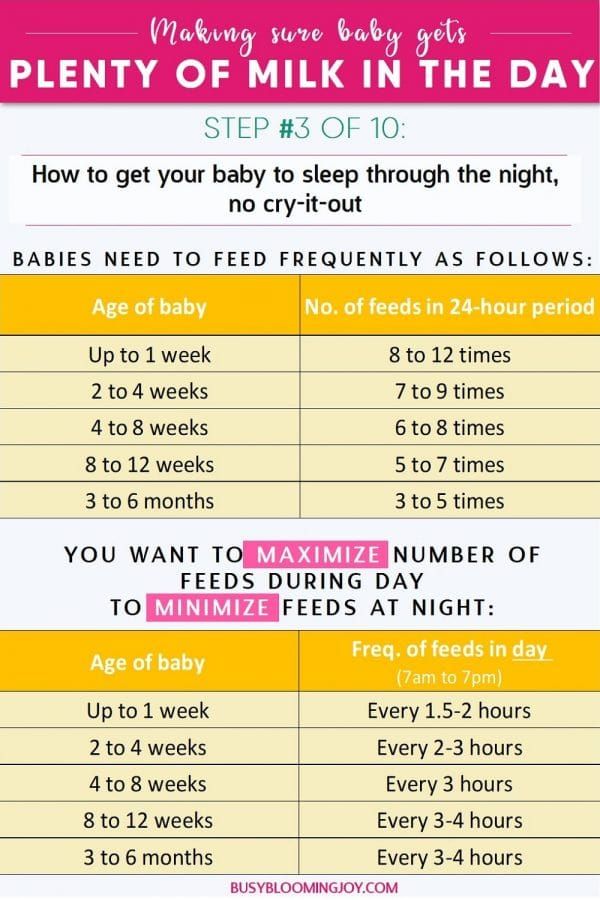
Identify the negative association with sleep and teach your baby to relax and fall asleep on their own. If necessary, contact a child sleep consultant.
4. The child does not sleep well due to unsuitable sleeping conditions.
Too warm pajamas, high/low temperature in the room, insufficient darkness or humidity, uncomfortable bed mattress, noise during sleep.
Review sleep conditions and change as needed.
5. The baby reacts to changes in the family.
Any deviation from the usual routine can affect a child's sleep: the imminent arrival of a second baby, moving to a new house, the appearance of a nanny.
Prepare your child in advance for important changes in the family so that they do not upset the usual daily routine.
6. Child wakes up hungry.
This happens if the baby did not eat enough during the day or his diet is not balanced. At this age, babies are often distracted while feeding and may become malnourished. They are more interested in exploring and playing with toys than sitting in a highchair.
They are more interested in exploring and playing with toys than sitting in a highchair.
Let's see how to establish a suitable feeding schedule at 12 months.
Child's diet
At the age of 1, a child's complementary foods already make up about half of his diet. It can be more or less - everything is individual.
The menu of complementary foods for a baby in the first year of life consists of 5 food groups: vegetables, fruits, meat, cereals and dairy products.
Feed your child one of the foods in each group every day for variety.
If he refuses one of the foods, do not force him to eat.
You will notice that by the age of one your child wants to eat from the common table. Children of this age already prefer to eat in pieces rather than in the form of mashed potatoes, and begin to eat with a spoon, drink from a sippy bowl or a cup.
Cooking methods can be different: baking without oil, stewing, boiling, frying in a pan with a non-stick coating.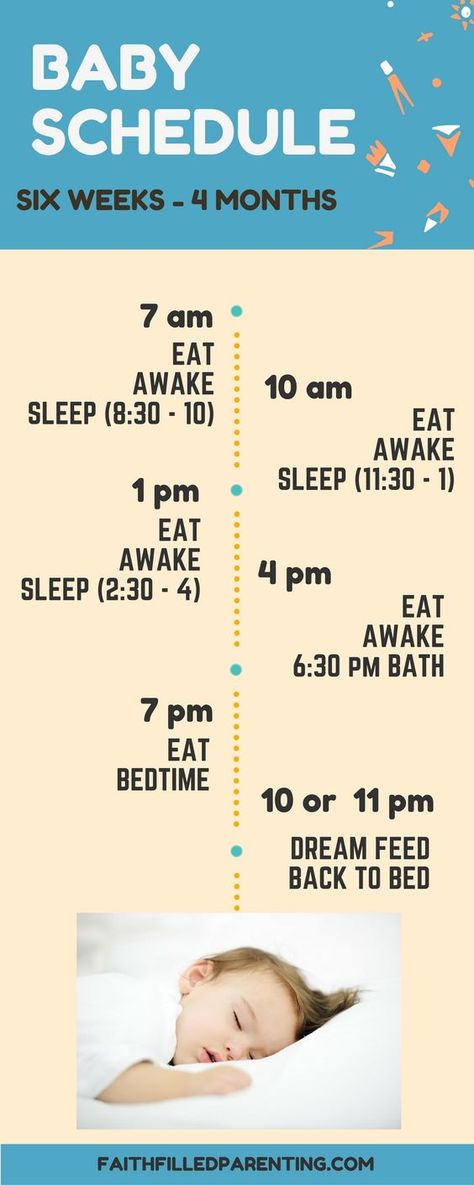 It is worth remembering that many children now prefer simple monocomponent dishes.
It is worth remembering that many children now prefer simple monocomponent dishes.
How many times a day should I feed my baby? Excluding breast milk/formula, the baby will eat up to 5 meals a day: breakfast, lunch, dinner and snacks.
Include in the menu: cereals, soups, steam omelet, meatballs, fish dishes and vegetables. Offer water, juice or compote, preferably without sugar. For an afternoon snack, you can give cookies, fruits or kefir. You can include cow's milk in the menu.
Avoid the following foods:
- smoked
- sweets
- fried food
- carbonated drinks
Child development per year
Every day of a one year old baby is full of new events and discoveries. He already understands how to behave in a family, is interested in other children, but does not yet know how to communicate with them. Reaches his hands to the toy he wants. The child knows how to get your attention.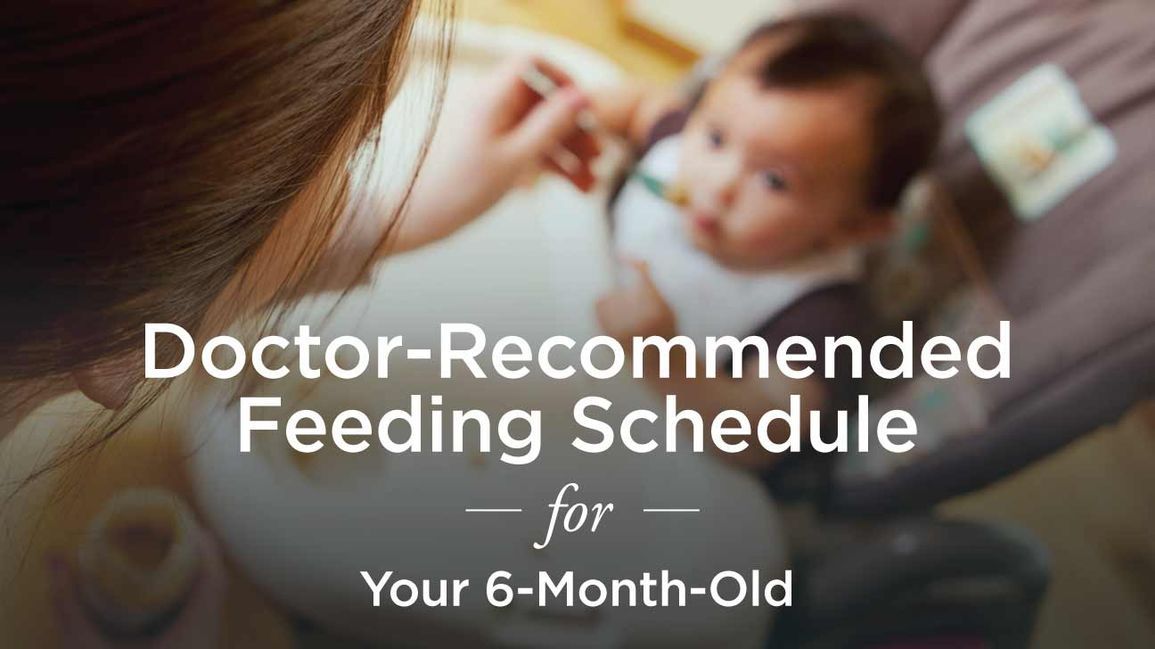
A one-year-old baby knows the names of objects that he sees around him every day. Soon he will utter his first, understandable word.
Speak out the actions that he takes to replenish the vocabulary of the baby and build a word-action connection. You can count the steps as you walk up the stairs, or name the colors of fruits and vegetables in the grocery store. It is also important to read picture books and ask the child to point and name familiar objects.
The child is already strong physically and can do a lot. He has already been sitting for a longer time and can turn in this position to reach for toys. Some babies learn to stand for a short time without support.
Babies are starting to walk. But don't worry if your child hasn't gone yet. Usually this skill is mastered by children in the period from 9 to 17 months.
What is your baby's daily routine by the age of one? Have sleep problems?
Like this article? Rate:
Votes: 387
newborn sleep and feeding schedule
02/26/2019
10
baby? But now you better understand your monthly baby and strive to organize a comfortable daily routine for your child. “What is important to consider at this age? How many hours of sleep and wake is enough for a child?
“What is important to consider at this age? How many hours of sleep and wake is enough for a child?
How to organize an exemplary diet and feeding of a newborn this month?” - Frequently asked questions by new parents. Let's explore them together!
Child's daily routine
1 month
In the first month of life, sleep is extremely important for the development of children, their growth and mood. Therefore, it is necessary to pay special attention to organizing the rest of the crumbs.
The baby sleeps approximately 17-20 hours a day. At the same time, some children of this age sleep more, others less.
Normally night sleep is 7-10 hours with awakenings for feeding, and daytime sleep is about 8-9 hours. With this mode, you will notice that the baby sleeps 4-6 times a day. It is important to remember that a newborn's daytime sleep can be either short (20-40 minutes) or longer (up to 3 hours).
This is due to the fact that the brain of a newborn is not yet physiologically mature, the biological clock is not formed, so the child does not have any clear regimen. It turns out that you will not be able to achieve one schedule daily yet. Also, leaving at night can change and be quite late. You will also notice that the baby during the rest gurgles, moves and does not seem to be actually sleeping. The fact is that now the child sleeps mainly in the fast phase, so now children's sleep is quite restless.
Waking time is the second important point that should be taken into account when shaping the routine of a one-month-old baby. On average, the baby should be awake for up to 60 minutes. Focus on the time that the child slept in the previous daytime sleep - as much as possible he can hold out in the state of wakefulness. This will also help organize the baby's routine this month.
Avoid overexertion and watch your activity time between naps.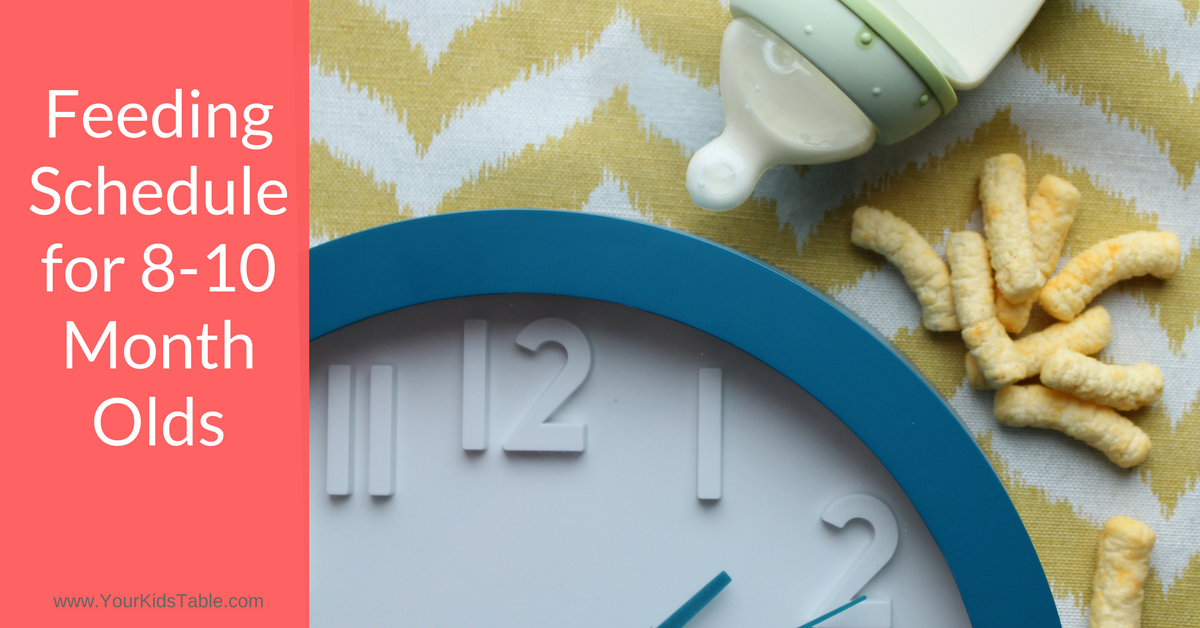 Do not be afraid to soothe a newborn baby by any means.
Do not be afraid to soothe a newborn baby by any means.
What can be done to make the baby sleep better:
- Swaddle your baby - so he calms down faster and does not wake himself up with his arms and legs.
-
Organize sleep in your stroller. Babies tend to sleep longer outdoors. How long it takes to walk depends on the time of year. In summer it is possible up to 2-3 hours in a row, in winter - depending on the weather conditions. If it's too cold outside, the best way out is to lay the child on the balcony.
-
If the baby has difficulty falling asleep in the evening, dim the lights in advance, turn on white noise.
- Use a sling or chaise longue if the baby is completely capricious.
- Start bedtime when you see the first signs of tiredness in your baby - this is exactly the time when he wants to sleep.
- Remember that changing your bed can wake up your baby.
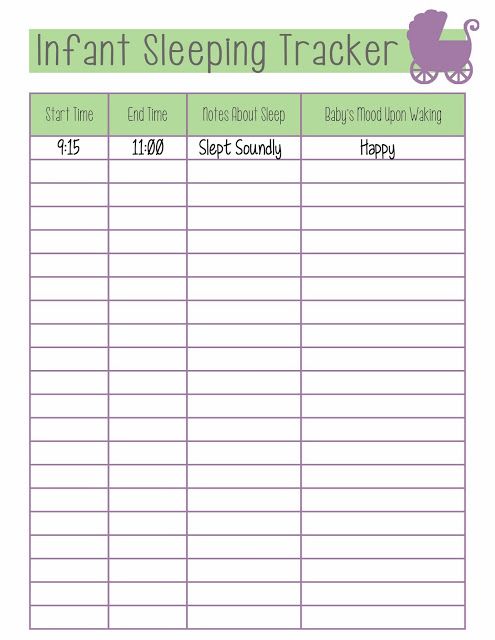 If you decide to transfer a sleeping baby from your arms to the crib, do it 20 minutes after falling asleep, when the baby is fast asleep.
If you decide to transfer a sleeping baby from your arms to the crib, do it 20 minutes after falling asleep, when the baby is fast asleep. - Bathe your baby before bed. Soon, bathing for him will be a signal to end the day and prepare for bed.
- Give your baby a pacifier if he can't sleep. Just remember that it is better to start using a pacifier when breastfeeding after lactation is established.
- Use a weak night light during night feeding.
Causes of poor sleep in a 1 month old baby can be:
1. Physical discomfort. In the evening, the baby may begin an attack of colic, which lasts from 2 to 6 hours. Support the baby in every possible way on such days - by 6 weeks relief will come. Also remember that the baby takes over your state. A calm mother is a calm baby. Therefore, try not to forget about your rest too and do not worry if the regime is violated.
2. Confusion of day and night. Due to the not yet formed circadian rhythms, a 1-month-old baby may sleep more during the day than at night. But already by 1.5 months, the baby will begin to sleep at night for up to 3-5 hours in a row. Take the baby to bright light during the day, and dim the light at night - so the baby's body will quickly adjust the internal clock. Try to start the morning early so that the child understands that the day has come. Carrying out hygiene procedures will become for him an association with the morning.
But already by 1.5 months, the baby will begin to sleep at night for up to 3-5 hours in a row. Take the baby to bright light during the day, and dim the light at night - so the baby's body will quickly adjust the internal clock. Try to start the morning early so that the child understands that the day has come. Carrying out hygiene procedures will become for him an association with the morning.
The table shows the sleep norms of a baby in the first month of life:
Baby feeding schedule
1 month
A newborn baby basically eats every 2-3 hours, regardless of the time of day. Therefore, do not worry if the child often wakes up at night now.
IV babies eat less frequently because formula takes longer to digest than breast milk.
Modern pediatricians advise in the first weeks of a breastfed child's life to organize meals on demand in order to establish lactation. Night feeding also occurs on demand.











